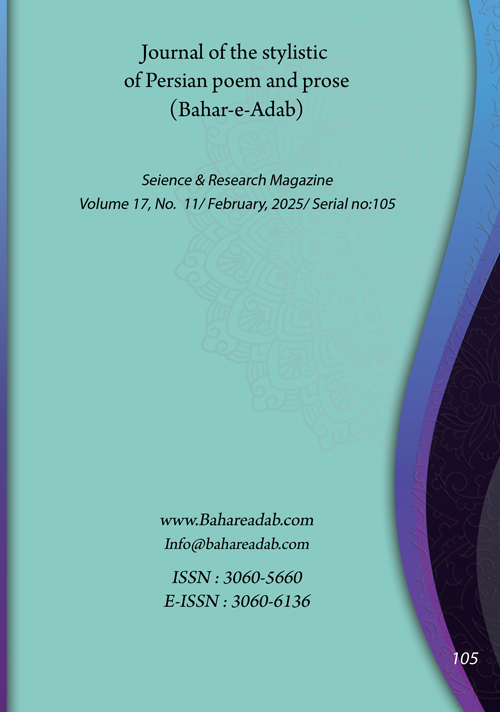- Count View : 29
- آدرس کوتاه شده مقاله: https://bahareadab.com/article_id/1765
- کد doi مقاله: Doi: 10.22034/bahareadab.2025 .17 .7638
Journal of the stylistic of Persian poem and prose
volume Number 17،
number In Volume 11،
،
issue Number 105
Intertextual analysis of uncertainty in the linguistic and narrative style of Boofe kour Sadegh Hedayat and Malakout Bahram Sadeghi
Marjan Hasanpour , Nahid Akbari (Author in Charge), Hesam Ziaee
Abstract
BACKGROUND AND OBJECTIVES: Intertextuality is one of the results of developments in the field of criticism and studies of literary texts. The main goal of this research is to analyze and investigate the factors of doubt at different levels of the narrative, considering the intertextual nature of the component of uncertainty in the two stories "Boofe kour" by Sadegh Hedayat and "Malakout" by Bahram Sadeghi.
METHODOLOGY: This research is based on library studies and document analysis method, using the descriptive-analytical method and referring to reliable scientific sources and databases. In this research, two books of Bofkor and Malakout have been analyzed and in order to provide statistical samples, 3000 sentences from each of these two intertextual works have been analyzed.
FINDINGS: In the two stories of Bufkor and Malkot, the proposition of uncertainty - which is one of the main coordinates of postmodern stories - is clearly evident, and this is the reason that, despite the categorization of these two novels under modern novels, it can be said that the component of uncertainty is Two works have given a postmodernist flavor.
CONCLUSION: In these two works, both authors have taken measures to express uncertainty, which are manifested in the levels of language, narration, characterisation, point of view, place and time of the story. Sadeghi Bamanand"s guidance mixes the world of fantasy and reality to make the audience suspicious. The novels of Bofkor and Malakout are close to the coordinates of postmodern novels, and the multiple and uncertain characterizations, the plurality of truth and reality, and the simultaneous use of fantasy and reality make the narrative space full of ambiguity and doubt in Bofkor, and Sadeghi in Malakout is also honest with the implicit intertextual approach. From Bufkor has paid attention to the manifestations of uncertainty in this story.
Keyword
implicit intertextuality. Boofe kour. uncertainty. Malakout
- Ahmadi. Babak (1991). Text structure and interpretation. Tehran: Nashr al-Karzan, p. 93.
- Azimi yancheshme. Ellahe . and Mir Baghri Fard. Seyed Ali Asghar (2016). Intertextuality as a method and insight into the history of modern literary writing. New literary essays. Number 196. pp. 1-22.
- Bart. Roland (2008). An introduction to the structural analysis of narratives. Translation: Mohammad Ragheb. Tehran: Farhang Saba, p. 21.
- Biniaz. Fathullah (2013). Palace literature in the fabric of loneliness. Tehran: Qaseidasera, p. 214.
- Boshruye. Hussein (2012). Habermas: critical attitude and evolutionary theory. Political-economic information. No. 72-74, p. 10.
- Fotouhi Roud Maajni. Mahmoud (2021). Stylistics; Theories, approaches and methods. Fifth Edition. Tehran: Sokhon, pp. 287-288.
- Hassanpour. Marjan and et all (2023). Analyzing and examining the link between intertextuality and modern narrative in Bufkor and the nocturnal synergy of Chobha Orchestra. Scientific Journal of Persian Poetry and Poetry Stylology (former Bahar Adab). 16th year Number eleven. Series 93. pp. 163-18.
- Hedayat. Sadiq (1972). Boofe kour. Tehran: Sepehr Printing House.
- Iranzade. Nemat allah and Liaghi Motlagh. Nafiseh (2016). Uncertainty in the metastory of possible night. Research paper on literary criticism and rhetoric. Year 6. Number 1. pp. 51-70.
- Lach. David (2007). Postmodernist novel: Theories of the novel. Translation: Hossein Payandeh. Tehran: Nilofar, p. 57.
- Makarik. Irnarima (2004). Encyclopedia of contemporary literary theories. Translation: Mehran Mohajer and Mohammad Nabavi. Tehran: Age, p. 112.
- Mavadat. Maryam and et all (2024). Analyzing the narrative style of the Persian postmodern story based on the semiotic pattern of Grimas (case study: the story of Christian and Kid and Prince of Ehtjab by Houshang Golshiri). Scientific journal of stylistics and analysis of Persian poetry and prose texts. (Former Behar Adab) 17th year The seventh number. Serial 101. pp. 140-171.
- McHale. Brian (2012). Postmodern stories. Translated by Ali Masoumi. Tehran: Phoenix, pp. 126-129.
- Meghdadi. Bahram (2013). Encyclopedia of literary criticism from Plato to today. Tehran: Cheshme, p. 97.
- Namvar Motlagh. Bahman (2007 a). An introduction to intertextuality: theories and applications. Tehran: Sokhn, p. 85.
- ______________________ (2007). Studying intratextual references in Masnavi with an intertextual approach. Research journal of humanities. No. 54. pp. 429-442.
- Nojomian. Amir Ali (2007). Essays of Barthes and Derrida. second edition. Tehran: Art Academy, p. 167.
- Payande. Hossein (2014). Opening the novel. Tehran: Marwarid, p. 329.
- _______________ (2011). Short stories in Iran (postmodern stories). Tehran: Nilufar, p. 447.
- Pour Yazdan Paneh Kermani. Arezou (2022) Representation of uncertainty in the novel Deilmazar by Mohammad Rudgar. Journal of Persian language and literature of Tabriz University. Year 75. Number 245. pp. 241-259.
- Priest. Graham (2004). Contradiction Translation and criticism: Rahmatullah Rezaei. Philosophical knowledge. first year. Number three. pp. 133-153.
- Rahadost. Bahar (2001). Characteristics of the postmodern novel. Career magazine. Year 80, No. 26, pp. 33-30.
- Rashidian. Abdul Karim (2014). Postmodern culture. second edition. Tehran: Ney Publishing, p. 177.
- Sadeghi. Bahram (1974). Mahakout. Tehran: Moin Publications.
- ______________ (1998). Writing is my destiny. Tehran: ASA, pp. 88-89.
- Shafi nia. Maryam and et all (1997). the end of certainties; Boutique of uncertainty in the postmodern novel of Posti. Literary Research Quarterly. Year 15, No. 61, pp. 106-75.
- Shamisa. Cyrus (2004). literary criticism Tehran: Ferdous, p. 326.
- Tadayoni. Mansour (2009). Rebirth of a legend. literary criticism Year 1. Number 2. pp. 63-82.

